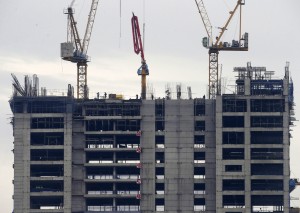5 ways your property can positively impact Earth

Construction of high-rise hotel and condominiums continues in Manila, Philippines and big cities in the country.AP FILE PHOTO
The construction sector leaves one of the biggest, and deepest, carbon footprints in the real estate industry, as cited by the organization Women In Construction.
The waste pile of the construction sector constitutes some of the country’s biggest garbage piles.
We have seen ecologically and socially responsible developers who are gradually building structures that would lessen the environmental impact of their structures in a country, which, incidentally, is among the most vulnerable to climate change.
As developers do their part in adding to sustainable practices, homeowners themselves can find ways to lessen their homes’ environment impact. Here are five tips:
1 Recycle construction materials. Recycle, reduce and reuse. And maybe save some money on the side. A piece of lumber from a local sustainable plantation has less environmental impact than imported forest timber. According to “True Green” published by the National Geographic Society, recycled lumber has even less impact.
“Recycled materials can also save you money and add personality to your environment. You can find bricks, roof tiles, floorings, windows, doors, fireplaces and fittings at salvage shops and junkyards,” stated the book authored by Kim McKay and Jenny Bonnin.
Even when recycled materials are not cheaper, you will be adding value to your home and helping create a market for recycled resources, which in turn will encourage others to recycle.
Look for local materials to save money and energy on your own transportation. And whenever possible, buy recycled, secondhand, reclaimed or waste timber.
2 Cooler roof, lower energy bills. Developing your roof’s heat-deflecting capabilities could also mean less dependence on air-conditioning and electric fans. Inquirer Property interviewed experts on ways to increase the roof’s cooling power.
Here are their tips:
• Use a roof sprinkler utilizing some of the used water stored in a tank or containers. Water is an effective way to cool down the roof, particularly during the hottest time of the day, and even at night.
•Architect Boy Morcilla suggested that a decorative wooden or cement board trellis built over your roof could deflect sunlight, and at the same time allow air to flow freely on the roof. If you decide to do so, plan the orientation of the trellis members so that they can offer the maximum shade during the time they are most needed.
• Put nature on the roof. The trees and shrubs around your house add to that “green” factor, absorbing that heat-retaining greenhouse gas carbon dioxide, and giving off refreshing oxygen during the day.
Landscape architect Paulo Alcazaren shared a simple rule for greening a city congested with buildings: What you lose on the ground you replace with greenery on top. He said that 1,000 square meters would be a fairly ideal area to maintain a roof garden. He added that a roof garden requires the proper selection of plants and maintenance of drainage and water supply. Once you plan to “green” your roof, do it correctly. Turning roofs into gardens has one immediate benefit: an estimated three- to five-degree reduction in temperature in the floors beneath.
3 Use the landscape. Make a feature of the contours in your garden by landscaping for water efficiency. According to “True Green,” make the most of water running off sloping, rocky and paved areas by bordering them with plant beds to absorb the water. Create depressions or ponds where water can collect to seep back into the ground and replenish the water table rather than going straight down the stormwater drain.
4 Support green structures. A third of the multinational corporations in the Philippines want their local headquarters in intelligent, eco-friendly skyscrapers. Architect Willie Coscolluela, principal architect of WV Coscolluela & Associates, once told Inquirer Property: “You’d be surprised that there are multinational companies with a corporate mandate indicating (they should be in a) green building.”
If you’re scouting for a home, carefully choosing developers with a green mindset (not just pretending to be green) could make a difference.
5 Be a bird sanctuary. Make your abode a desirable destination for many kinds of birds. They like taller trees for roosting and nesting, shrubs for flowers and fruits, and clearings to hunt for seeds and insects. “True Green” suggested that one should create a pesticide-free haven of native plants, hollow logs, or bird houses along with a supplemental food and freshwater supply.
Why birds? They bring life to a garden, providing color, movement, sound and useful fertilization and pest control services. They consume up to half their weight in weed seeds, pests, rodents and insects each day, and they pollinate flowers and scatter valuable plant seeds. With the rapid destruction and degradation of habitat, the backyard garden has become an increasingly valuable potential habitat.














